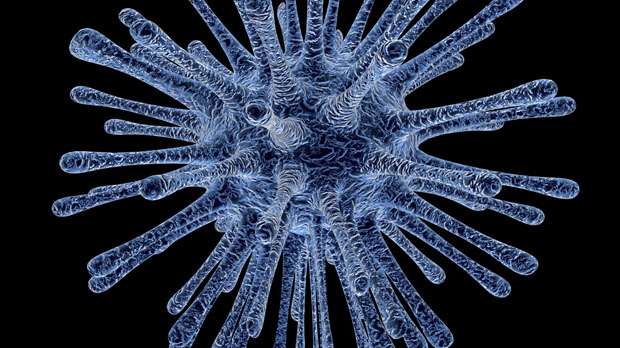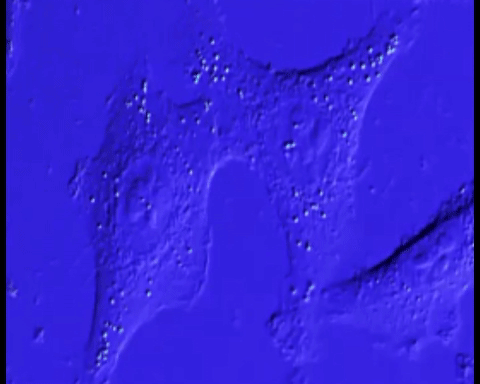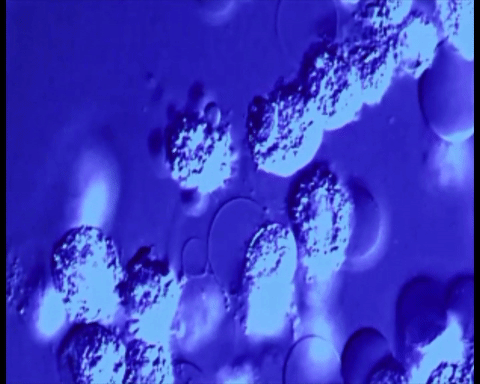Training viruses to be cancer killers

For decades, scientists and doctors have looked for ways to stop the damage that viruses cause to humans.
But in recent years, certain safe, modified viruses have emerged as potential allies to tackle cancer.
And our scientists are among those searching for new forms of cancer-killing viruses.
Previous studies have shown that some viruses naturally kill cancer cells, but how they do this has never been fully understood.
Professor Len Seymour's lab, at the Cancer Research UK Oxford Centre, has been focusing on one particular cancer-killing virus that operates under the code name of Enadenotucirev (or EnAd for short).
And a new study, published in Molecular Therapy – Oncolytics, has revealed EnAd to have a rather unusual method of killing cancer cells.
Caught at the scene of the crime
Arthur Dyer, a researcher in Professor Seymour's lab, and the team have installed their own version of 'cell CCTV' to catch the act of cell-killing on camera.
The footage below was recorded using a normal light cell microscope, commonly found in a lab that takes a snap every minute.
"Each frame is one photo taken every minute and then we've stuck all the photos together as a video," says Dyer. The end result is the clip below:

Dyer explains: "Here we've got human lung cancer cells in a dish and we've infected them with a virus that's trained to kill cancer cells."
This lab technique has given researchers valuable intelligence as to how EnAd kills cancer cells.
"When the cells are infected with the virus they balloon up, blister and then die," says Dyer, adding that it was a cause of cell death he'd never seen before.
"When I first saw it I thought I was going mad. It's such a weird cell death, it seems to use up the energy in the cell which then causes it to swell."
Ways to kill a cancer cell
One of the ways in which viruses survive in the human body is by hijacking healthy cells' internal machinery.
EnAd takes over the cancer cells' machinery, using up the cell's energy to such an extent that it has no more strength left to live.
"This virus needs cells that are already hyperactive," adds Dyer, explaining that as the metabolism of cancer cells has gone haywire they make the perfect victim.
Cells normally die in a very controlled way, but these cancer cells balloon up to 2 or 3 times their size, giving the appearance of blistering.
And it's this precise effect that gives EnAd potential to be a great cancer cell killer.
Cancer cells can disguise themselves from the body's immune system, but when EnAd destroys cancer cells in the lab it leaves the 'crime scene' upturned, with lots of evidence carelessly left behind. Seymour's team believe this could encourage the immune system to ring the alarm for other immune cells to come and investigate the scene.
And to test this further, they've been putting lots of versions of the virus to work in the lab.

How to train a virus
Seymour's team has made sure they've got the deadliest of cancer cell killers by using a tough training programme.
"Viruses are naturally good at killing cancer cells so even harmless ones have some ability to attack them," says Dyer.
"But to find the best virus, we grow them repeatedly in cancer cells and compare them all head to head."
It's important that the virus can tell the difference between healthy tissue and cancer cells. So the team also tests them on healthy cells to make sure the viruses can't grow in them.
"So at the same time we also look for the ones that are least able to infect normal cells," says Dyer.
This tough selection process leaves the viruses with only one mission: to infect and destroy cancer cells.
The future's bright for cancer-killing viruses
EnAd has passed these lab examinations and is now being tested in an early stage clinical trial in a very small number of people.
"These trials are making sure the virus is safe and to find the best way to give it to the patient. Ideally we'd like to use an injection so the virus can get into the bloodstream and reach cells that have gone to other parts of the body," says Dyer.
Some cancers can also become resistant to the ways in which treatments destroy them. But because EnAd has a different method of destroying cancer cells, Seymour's team believes the virus might also be able to kill cancers that have become resistant to treatment.
Ultimately, the team hopes to test how it performs with other drugs and in specific types of cancer, bringing it that little bit closer to becoming a new ally for targeting cancer.
More information: Arthur Dyer et al. Oncolytic Group B Adenovirus Enadenotucirev Mediates Non-apoptotic Cell Death with Membrane Disruption and Release of Inflammatory Mediators, Molecular Therapy - Oncolytics (2017). DOI: 10.1016/j.omto.2016.11.003
















